Impulsstøj
Summary and conclusions
Introduction
In the Danish guidelines for measurement of environmental noise it is stated that a penalty of 5 dB shall be added to the measured LAeq if clearly audible impulses are present in the noise. Results from an interlaboratory test with 38 participating Danish laboratories showed not surprisingly that there was a strong need for more specific guidelines on this topic.
The purposes of the present work were:
- To define the concept of "impulse" in relation to annoyance for environmental noise.
- To describe the psychoacoustic background for measurements of the audibility of impulses.
- To develop an objective measurement method, if possible. It is emphasised that the method shall be so simple to use that the approved Danish laboratories can use it for practical noise measurements with generally available measuring equipment.
Neither the Danish guidelines nor ISO 1996-2 Amd.1 1998 give a definition of impulsive sound. The only guidelines in these papers are a number of examples of sound sources. However, it is not the sound sources, but the perceived sound which is the objective.
Therefore, first of all we need a clear definition of impulsive sound starting at the perceived sound. From there we can go on with the search for a physical quantification with optimum correlation to subjective ratings of the sound.
In the report a method for measurement of the prominence P of the impulses is described. Based on the assumption that the prominence of the impulses plays an important role for the annoyance, the prominence is transformed into a graduated adjustment to LAeq.
Listening tests
In general listening tests are called subjective, but listening tests may give objective answers.
The results of listening tests can be characterised as objective when the test persons are asked to quantify or compare specific and well-defined characteristics. This kind of measurements is called perceptive measurements or auditive analyses. The characteristics to be evaluated may be defined either by words or by examples, so that the test persons (trained persons: "experts") know exactly what to listen for. Preferences are not asked for.
If we ask for preferences, the listening tests are subjective. Such tests are called affective tests or preference tests. The answers depend on the perceived sound, but are influenced by the selected group of people, their knowledge of and attitude to the sound sources, their expectations, the circumstances and context of the interviews or the evaluations, etc. An example of this kind are investigations of annoyance. For the reasons just mentioned annoyance measurements in a laboratory are doubtful. The term "annoyance potential" may be a proper name for such kinds of measurements.
So, if we want objective answers from the test persons quantifying the prominence of the impulses, we need a clear definition of an impulse.
For the purpose of the listening test the following general definition was applied:
"Impulsive sounds are sounds of any duration with a sudden onset, which attracts attention through the continuous part of the noise, including the background noise.
Impulsive sounds are characterised by their sudden onset, which makes the noise noticeable. This means that the impulses may make it easier to identify the sound source. Impulses may be heard louder than continuous noise types."
Please note that the impulse is defined as the sudden onset and not the sound as a whole. The idea is that the concept of impulsiveness shall be connected to the startle effects. If the sound has a long duration, only the sudden start shall give a penalty for impulsiveness. If the high level of the sound continues, this level will contribute to the total value of LAeq.
We search for a physical measure that correlates with the perception of impulses. - But what we really want is a measure that correlates with the (extra) annoyance caused by the impulses. For these investigations we made the assumption that the specific annoyance potential of the impulses in different noise examples can be measured relatively to each other when the sounds were presented with the same LAeq. Furthermore it is assumed that the prominence of the impulses plays an important role for the annoyance.
Result of the listening tests
5 experts and a test panel of 12 "ordinary" people participated in the listening test on industrial and other sounds. Three groups of noise examples were presented to the listeners:
Group L: |
LAeq = 40 dB of the noise samples. LAeq= 40 dB of background noise. 17 listeners (panel + experts). Artificial head recordings of "real sounds" presented on headphones. The sound samples were unknown to the listeners. |
Group H: |
LAeq = 60 dB of the noise samples. LAeq = 40 dB of background noise. Rest as group L. |
Group P: |
LAeq = 60 dB of the noise samples. No background noise. 5 listeners (experts). Mono recordings of artificial and "real sounds" presented on headphones. The listeners knew the sound samples from a laboratory proficiency test. |
It is seen that the P-group differs from the L- and H-groups in several aspects.
Each sound had a duration of approximately 30 sec. and was presented together with natural background noise with a constant A-weighted level of 40 dB. The sample numbers were announced with (calibrated) natural speech. The artificial head recordings were presented twice over calibrated open headphones. 12 photographs (42 ´ 60 cm) from outdoor residential environments were put on the walls of the listening room.

Figure 1
Example of a 15 cm answering scale for the listening test. The test persons were
instructed to judge the perceived sound and not the nature of the sound source.
All test persons were asked to judge the prominence, the degree of intrusiveness of the impulses and the "annoyance" of the sounds under the assumption that the examples were representative of the noise outside their residence. Scales as the one shown on Fig 1. were used. The 5 experts were furthermore asked to mark on a fivepoint scale whether they judged the impulses to be so clearly audible that a 5-dB penalty should be given.
There was high correlation (up to R2 = 0.98 on the parameter "prominent") between the mean values of the answers from the experts and the answers from the test panel. The standard deviations of the answers from the test panel were a little larger than for the experts.
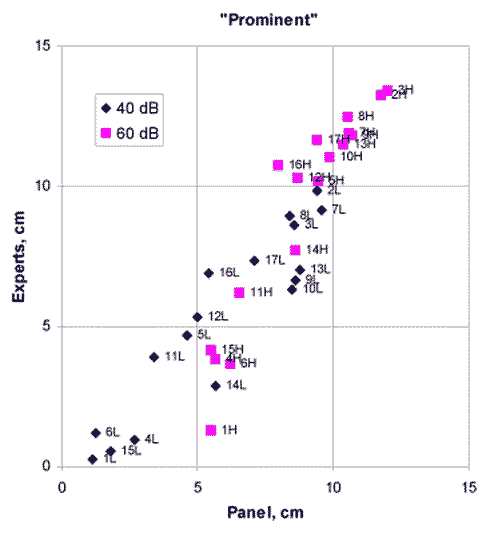
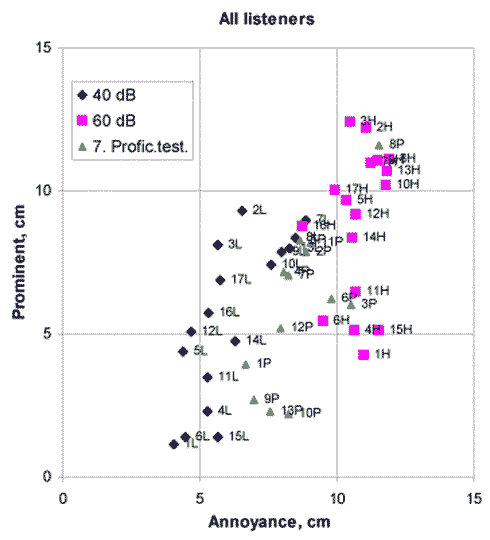
Figure 2
The left figure shows the correlation between the judgements of the test panel and the
experts for the prominence of the impulses. The right figure shows the relation between
"annoyance" and "prominence" for all listeners. "40 dB" and
"60 dB" refer to the LAeq of the examples.
"7.profic.test" refers to a group of 13 examples presented at LAeq
= 60 dB to the experts only and without background noise.
The examples at LAeq = 60 dB was in average found to be 4.6 cm more "annoying" than the more distant sounds at LAeq = 40 dB. There was a high correlation R2 = 0.97 between "prominent" and "intruding", so there is no reason to distinguish between these two terms. The correlation between "annoyance" and "prominent" was only R2 = 0.67.
There was the same ranking of the prominence of the examples at the two levels, but the average judgement of the prominence of the impulses was 3.4 cm higher for LAeq = 60 dB than for LAeq = 40 dB. (The background noise level was 40 dB(A) in both cases).
Auditive analysis - a temporary solution?
The listening tests showed good correlation (R2 = 0.90 for the shown curve) between the 5 experts' judgements of the prominence and penalty, see Figure 3.
This gave the idea of performing the measurements of the prominence as an auditive analysis. This could be done by gathering the examples from the listening tests on a reference CD together with a catalogue with the results from the listening test. The result from the listening test - for the example with the greatest resemblance with the actual noise - should then be the starting point of the relative judgement of the prominence of the impulses on an axis as in Figure 1. The definition of impulses is given in the last paragraph of Section 3. By means of Figure 3 this judgement could then be converted to a penalty to be added to the measured LAeq for the actual noise.
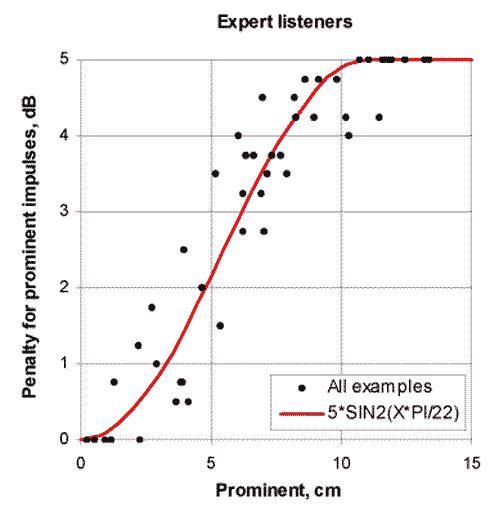
Figure 3
The relation between the experts' judgements of prominence of the impulses and their
tendency to impose a penalty.
Listening test results and physical measurements
Metrics with one parameter
The correlations with the results from the listening test (all the three groups of noise examples: L, H, and P) and a number of physical measures have been investigated.
The following metrics based on the A-weighted sound pressure levels with time weighting F were tested. (Of the standardised time weightings S, F, and I, F gives the best approximation to the loudness perception. Therefore the investigations have concentrated on measures with time weighting F): LAmaxF - LAeq in one-second periods, LA,F - LA,S as a running measurement, and LAmaxF,30sec., LAmaxF - LAeq,30sec., and LAmaxF - LA95 in 30-second periods. Onset rate (dB/s) and level difference (dB from background SPL to 90% of max. SPL). F and S denote time weightings F and S, respectively. Furthermore the A-, B-, C-, and D-weighted Leq-values were tested.
One of the reasons that psychoacoustically related metrics may be more relevant for impulsive noise than descriptors based on A-weighted levels is the following: When an impulse occurs, the bandwidth of the total noise spectrum becomes wider. When the bandwidth becomes more broadbanded, there will be an increase in loudness, but not necessarily in the A-weighted level.
The following psychoacoustic measures were tested: Loudness (sone), sharpness (acum), roughness (asper), fluctuation strength (vacil), onset rate (sone/sec.) and level ratio (sone/sone) from background level to 90% of max. level).
Results are shown in Table 1.
|
All listeners / Experts only |
||
Physical measure |
"Prominent" |
"Annoyance" |
5-dB penalty |
LAeq |
0.11 / - |
0.58 / - |
|
Max (LAF - LAS) |
0.36 / 0.42 |
|
- / 0.49 |
Mean of 3 Max (LAF - LAS) |
0.32 / 0.42 |
0.05 / - |
|
Max (LAmaxF - LAeq,1 sec.) |
0.36 / - |
|
- / 0.47 |
LAmaxF |
0.26 / - |
0.54 / - |
- / 0.22 |
LAmaxF - LAeq,30 sec. |
0.30 / - |
0.06 / - |
- / 0.41 |
LAmaxF - LA95,30 sec. |
0.34 / - |
|
- / 0.47 |
Level difference [dB(A)] |
0.36 / - |
|
|
Log (level difference [dB(A)]) |
0.42 / - |
|
|
Onset rate [dB(A)/sec.] |
0.36 / - |
|
|
Log (onset rate [dB(A)/sec.]) |
0.57 / - |
|
|
Number of impulses per minute |
0.00 / - |
0.00 / - |
|
Log (level difference [son-ratio]) |
0.48 / - |
|
|
Log (onset rate [son-ratio/sec.]) |
0.39 / - |
|
|
Psychoacoustic annoyance |
0.54 / - |
|
|
Sharpness |
|
0.15 / - |
|
Fluctuation strength |
0.41 / - |
0.46 / - |
|
Roughness |
|
0.14 / - |
|
Table 1
R-squared values for the correlation between physical measures and the results from
the listening test. The figures are based on all the tested noise examples. LAF
- LAS (theoretical max. = 8.9 dB) is measured by a running process as the
difference in dB in the outputs from two RMS-detectors with time weightings F and S.
On this background it was concluded that no single parameter can characterise - with sufficient accuracy - the prominence of the impulses or the extra "annoyance" (extra = the part of the "annoyance" not already explained by LAeq) caused by the impulses.
Metrics with more than one parameter
The main conclusions are based on the L- and H-samples, with additional analysis performed on all noise examples.
The data analysis is mainly based on linear regression with the average of the listeners' judgements of "Prominent" as the Y-input and one or more objective measures or transformations of these as variables. Test for the significance of the variables was also made.
Good correlations were found between "Prominent" and the logarithm of the onset rate and the logarithm of the level difference. The best results of the A-weighted variables were obtained with the following combination: 2.41 · log (onset rate) + 3.43 · log (level difference); R2 = 0.74 for L- and H-samples and R2 = 0.57 if P-samples were included.
For a similar combination of psychoacoustic data R2 = 0.75 was obtained for L- and H-samples and R2 = 0.60 if P-samples were included. If also sharpness was included, the R2-values increased to 0.78 and 0.61. The highest R2-value was 0.83 obtained with a combination of several psycho-acoustic parameters.
Definition of impulsive sound
In the listening tests high correlation was obtained between the listeners' response and an objectively combined psychoacoustic measure. This is taken as an indication of the definition of impulses used in the listening tests being capable of leading to systematic judgements of impulses. Therefore the following definition is suggested for impulsive sounds:
The sudden onset of a sound is defined as an impulse |
With this definition the judgements of impulses do not have to depend on the type of sound source, but may be based on how prominent the impulse characteristic is perceived.
Perceived prominence
A combined measure consisting of onset rate and level difference gave good correlation with the listening tests (R2 = 0.74). Higher correlations were obtained with psychoacoustically based measures, but these are still considered too advanced for practical use.
A result based on a combination of the psychoacoustically related measures for level difference (sone ratio: sonebackgr./sonemax.), onset rate (sone ratio/s), and sharpness are shown in Figure 4. Al-though this seems promising, an A-weighted measure was preferred for practical reasons.
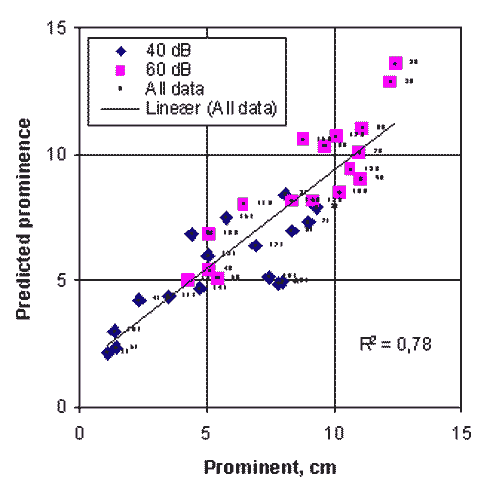
Figure 4
The listeners' judgements of "Prominent" and the prominence predicted from
psychoacoustic measures based on sone and sharpness.
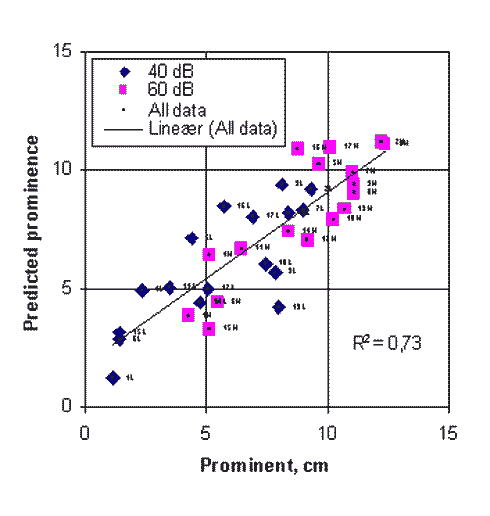
Figure 5
The listeners' judgements of "Prominent" and the prominence predicted from
A-weighted measures with time weighing F.
As mentioned a linear combination of log (onset rate) and log (level difference) gave the highest R2-value, but the constants were not critical, low values for slow (50 km/h) car passes-by and high values for sharp and loud artificial pulses. The measure was furthermore designed to give a maximum around 15.
The optimised equation which gave an R2-value of 0.73 is:
Predicted prominence: P = 3· log (onset rate) + 2·log (level difference) (1) |
where the "onset rate" in dB/s and the "level difference" in dB are defined in Section 5. Log is the logarithm with base 10. The correspondence with the listeners' judgements is shown in Figure 5.
Note: |
The general form of the expression for P is: P = k1 · log (onset rate) + k2 · log (level difference). The constants k1 and k2 are adjusted to obtain a high R2-value both with and without the P-samples. It is also taken into account that the relation between P for very sudden and loud impulses and P for slow level changes shall be large. The measure was furthermore designed to give a maximum around 15. With the constants given in Equation (1) the predicted prominence explains 73% of the variance in the answers from the listening test. |
From the definition "The sudden onset of a sound is defined as an impulse" it seems reasonable to express the impulsiveness of an event as a combination of onset rate (how suddenly the sound starts) and the level difference (how much the level increases). Although psychoacoustic measures for these characteristics give the best results, the A-weighting and the time weighting F for this purpose seem to give an acceptable and practical approximation to the characteristics of the hearing.
Adjustment to LAeq
Many researchers have found that impulsive sounds are more annoying than other sounds with the same LAeq. Therefore there is a need for an adjustment or penalty to the measured LAeq for impulsive sounds. The adjustment of LAeq for impulses shall not depend on the type of sound source, but on how prominent the impulse characteristic is perceived through the continuous part of the noise, including the background noise.'
For sounds with onset rates larger than 10 dB/s the following adjustment KI, based on the predicted prominence P, may be applied:
Adjustment to LAeq: KI = 1.8 · (P - 5), for P > 5, KI = 0 for P £ 5 (2) |
It is suggested that this adjustment is made to LAeq,30min on the basis of the one event with the maximum value of P in the 30-minute period.
Figure 6 illustrates Equation (2) and shows the adjustment KI to LAeq for some noise examples.
Note 1: |
The general form of Equation (2) is: KI = k3 × (P - k4), for P > k4, KI = 0 for P £ k4. The constant k3 gives the inclination of the correlation between KI and P, and k4 defines the lower limit for adjustment to LAeq. The constants k3 and k4 are preliminarily set to give an approximate correspondence with the extra annoyance reported in the literature for different kinds of noise sources. The adjustment is not made on the background of the listening tests in the present study. As the annoyance depends on the level and characteristics of the noise, the kind of sound source, the context and social factors, and as the adjustment KI is meant to compensate for the extra annoyance from the impulses, it might be considered to operate with sourcerelated and/or level-dependent values of k3 and k4. |
Note 2: |
The time period of 30 minutes for adjustment of LAeq is set as a preliminary period from considerations of reasonableness and ease of measurements and administration. There are no systematic investigations behind this period, and the principle should be considered in more detail when such investigations are made. |
Figure 6 Se her!
The adjustment to LAeq as function of the prominence (X), Equation
(2), with noise examples.
Definitions for the Measurement Method
Measurements shall be made on the basis of the A-weighted sound pressure level with time weighting F. If digital sampling is involved, the output of the F-detector shall be sampled at least every 25 ms. Measurements made on the basis of shortterm Leq-values (e.g. 10 ms) shall (e.g. by computation) be approximated to time weighting F before the readings of onset rate and level difference are made.
Definitions:
|
The values of level difference and onset rate may be found from analogous or digital level recordings. The results may also be found by measuring the reverberation time T of the reversed events. In this case the onset rate is 60/T. (Some systems are capable of measuring T of the onset without reversing the signal).
Conclusions
Together with a preliminary explanation of impulsive noise to the listeners, a distinction between subjective and objective results in the performed listening tests has led to a definition of impulses.
A measurement method for the prominence, P, of impulses is developed on the basis of A-weighted measurements with time-weighting F. The prominence is found as a combination of onset rate (how suddenly the sound starts) and the level difference (how much the level increases). The timeweighting F is an approximation to the dynamic characteristics of the hearing system and the method correlates well with the average of listeners' perception of impulses.
Slightly better results were obtained with measurements based on psychoacoustic parameters, but these are still considered to be too advanced for noise measurements in practice.
The prominence, P, is transformed into a graduated adjustment KI to LAeq for impulses. The more prominent the impulses are, the larger the adjustment.
The relation between P and KI is set by two constants k3 and k4. These constants are set to be in reasonable accordance with findings in the literature, but should be considered in more detail.
The method provides the possibility of operating with different adjustments for different categories of noise sources.
The time period for adjustment of LAeq is preliminarily set to 30 minutes. This period should indeed be considered when further investigations are made.
A more precise description of a measurement method is developed in a NORTEST project and will be published from NORDTEST and on www.delta.dk.
List of Danish words
This list of words is meant as a help to understand figures, tables and main results in the Danish report.
Afvigende, deviating
Andel af forklaret varians, fraction of explained variance (R2)
Antal, number
A-vægtning, A-weighting
Baggrund, background
Baggrundsstøj, background noise
Beregnet, calculated
Billeder, pictures, photographs
Bolig, residence
Expertlyttere, expert listeners
Extern støj, environmental noise
Farve, colour
Flerdimensionale, multidimensional
Forhold, condition
Formål, purpose
Forslag, proposal
Forsøgspersoner, test persons
Redigering, editing
Rækkefølge, order
Sammenhæng, correlation
Sammenlignende måling, proficieny test
Skæring, crossing
Spørgsmål, question
Standard afvigelse, standard deviation
Forudsætning, presumption
Forventning, expectation
Gene, annoyance
Gennemsnit, average
Gruppe, group
Grå, grey
Hovedresultater, main results
Humør, mood
Hyppighed, frequency
Højre, right
Hørbar, audible
Hørbarhed, audibility
Hørelse, hearing
Hørestyrke, loudness
Hørestyrkeniveau, loudness level
Jævn, continuous
Karakter, characteristics
Kombineret, combined
Stejlhed, onset rate
Støj, noise
Støjbelastning, noise exposure
Svarskema, answering form
Sædvanlig, normal
Tidsvægtning, time weighting
Tillæg, adjustment
Tydelig, prominent
Kunsthoved, artificial head
Lyd, sound
Lydeksempel, sound exsample
Lyttepanel, panel of listeners
Lytter, listener
Lyttetest, listening test
Middelværdi, mean value
Miljø, environment
Miljøstyrelsen, Danish Environmental Protection Agency
Mål, measure, metric
Målemetode, measurement method
Måling, measurement
Niveau, level
Opgave, task
Optagelse, recording
Punkt, point
Påtrængende, intrusive
Sammenfatning, conclusion
Udstyr, equipment
Vejledning, guideline
Venstre, left
Virksomhed, activity, industry
Vurdering, judgement